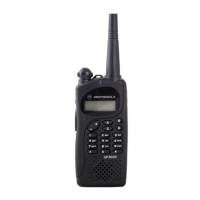G-4
Private Line (PL) A sub-audible tone/code used to create unique/private communication groups
while operating in Conventional Dispatch mode. A generic term for Tone Private
Line (TPL), or Digital Private Line (DPL).
Program The transfer of CPS information from the computerÕs temporary memory (RAM)
to the radio.
PTT Push-To-Talk: the switch located on the left side of the radio which, when
pressed, causes the radio to transmit.
PTT ID Select If PTT ID is activated for the channel, then PTT ID will be sent following the PTT
ID Transmission Type.
PTT Short Sidetone PTT Short Sidetone causes the radio to sound one short alert tone, after the
PTT button is pressed, and immediately following the ID being transmitted. The
purpose is to indicate to the radio-user when voice may be initiated.
Random Access
Memory (RAM)
A temporary storage space used by a computer to operate a software program
currently running. Anything stored in RAM is lost when the computer is turned
off.
Registers Short-term data-storage circuits within the microcontroller.
Repeater Remote transmit/receive facility that retransmits received signals to improve
communications coverage.
RESET Reset line: an input to the microcontroller that restarts execution.
RF PA Radio Frequency Power AmpliÞer.
Radio Interface Box
(RIB)
Used to connect a personal computer to a radio for the purpose of communi-
cation between the two. The RIB consists of level-shifting circuits that convert
from the standard RS-232 voltage levels of the computer asynchronous serial
interface (COM Port) to the single-ended voltage levels present on the Serial
Bus contacts of the radioÕs connector. The RIB must have an appropriate RIB-
to-radio and RIB-to-computer Radio Interface Cable for communication and ra-
dio programming to occur.
Receive Frequency A designated frequency used when receiving carrier for the current channel.
Reverse Burst /
Turn Off Code
Causes a Tone Private Line (TPL) or Digital Private Line (DPL) code to be
transmitted at the end of a transmission - once PTT is released, and while op-
erating on the current channel. This sub-audible tone causes the receiving ra-
dio to mute its speaker before loss of a carrier is detected. Muting the speaker
eliminates unwanted noise (squelch tail) during loss of carrier detection.
ROM Read Only Memory.
RSSI Received Signal-Strength Indicator: a dc voltage proportional to the received
RF signal strength.
RPT/TA Repeater/Talk-Around.
Rx DPL Code The speciÞc code accepted when receiving Digital Private Line (DPL) encod-
ing, while operating on the current channel.
Rx DPL Invert Setting Rx DPL Invert causes Digital Private Line (DPL) signals to be inverted
when they are received by the radio, while operating on the current channel.
Inverted coding allows for more trafÞc/usage on frequencies.
Term DeÞnition

